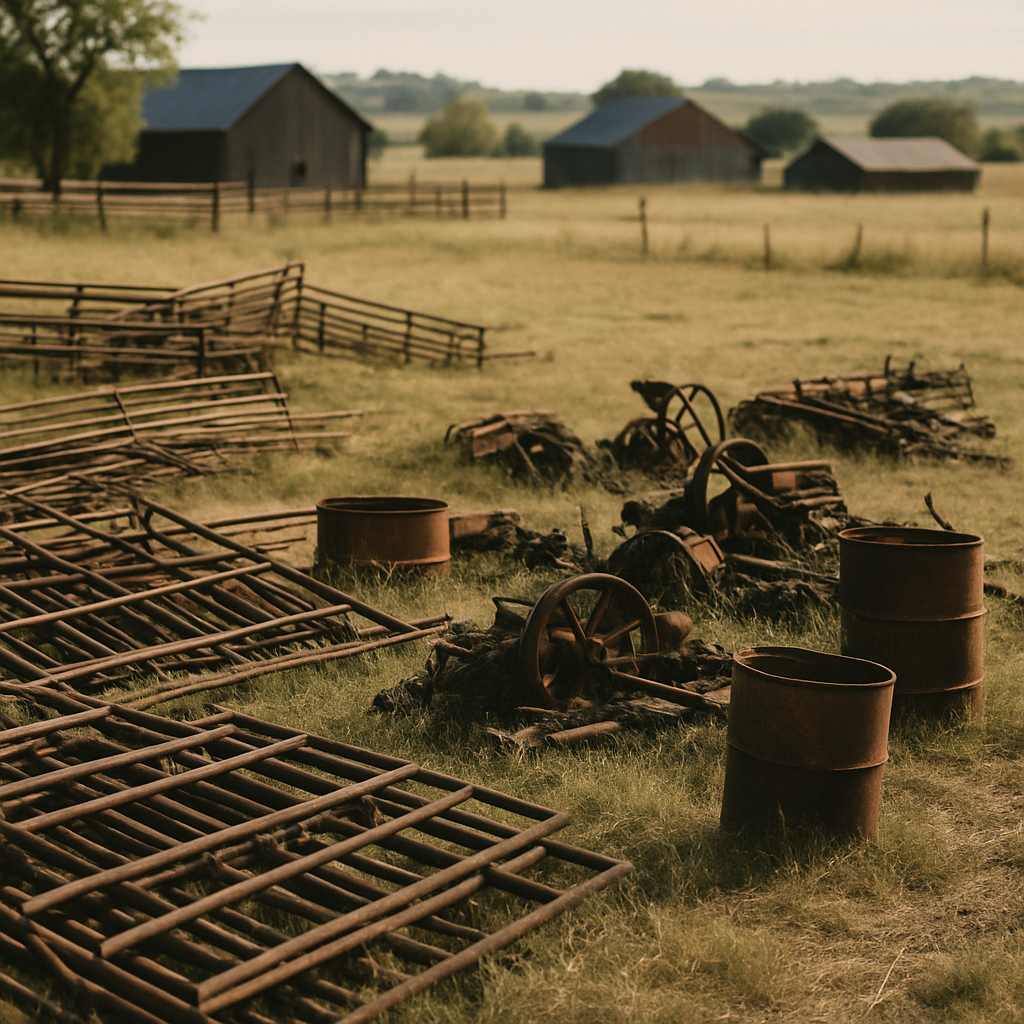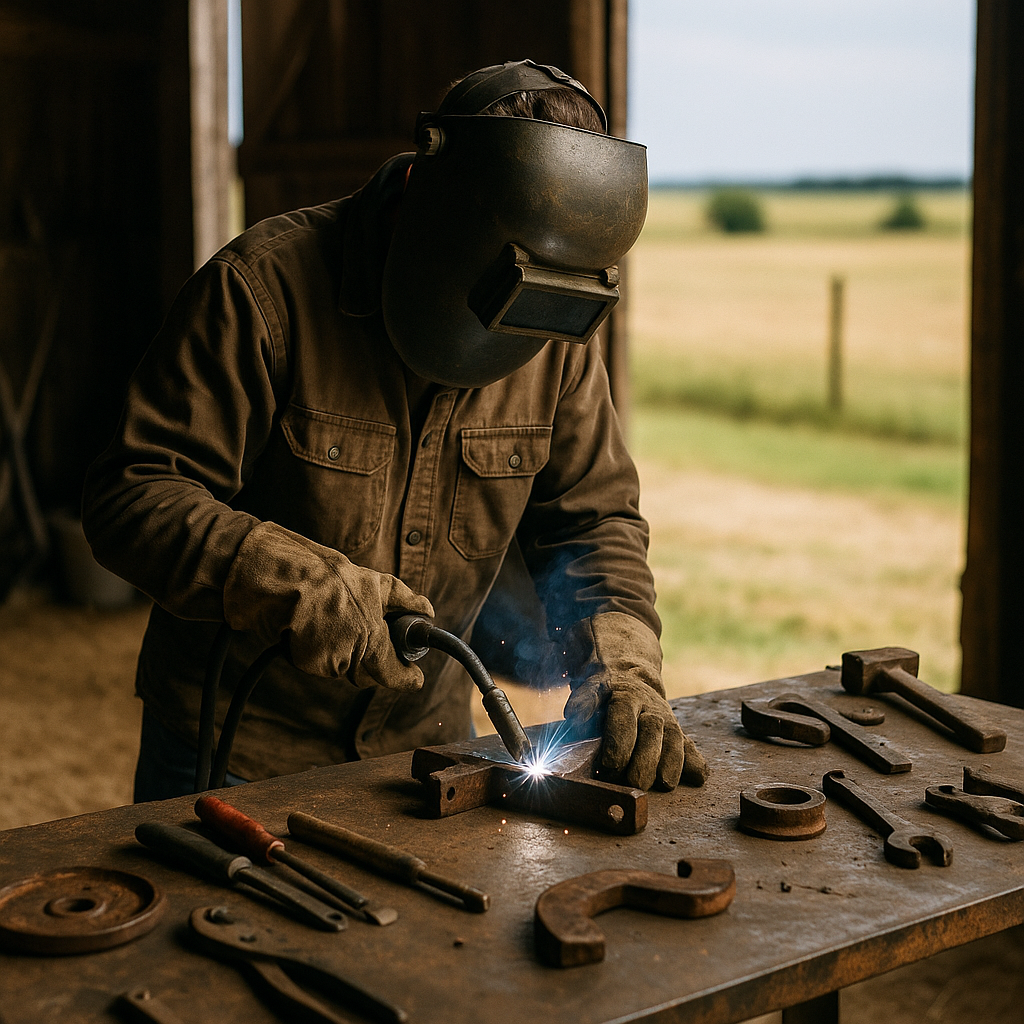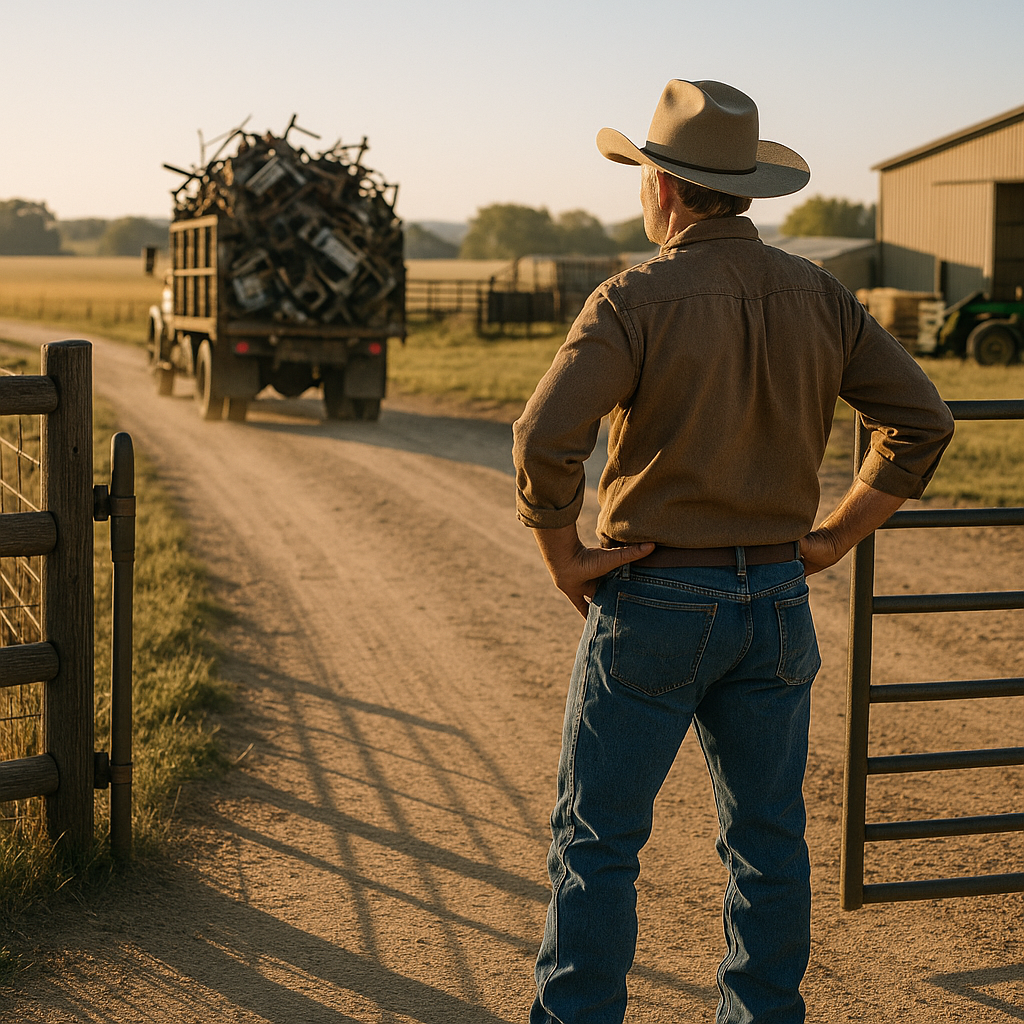5901 Botham Jean Blvd, Dallas, TX 75215
The Value of Scrap Metal from Ranch Fencing and Infrastructure
August 6, 2025Jake Wilson had walked the same stretch of his family ranch for decades. One morning, while inspecting a section of the old fence damaged in a recent storm, a realization struck him. The pile of twisted metal posts, rusted wire fencing, and weathered gates wasn’t just a cleanup headache—it represented untapped value. What had always been viewed as an eyesore could actually be transformed into cash or repurposed for new life around the property.
This discovery isn’t uncommon for farmers and ranchers today. Across agricultural properties nationwide, tons of metal materials accumulate over years of operation. Fencing sections, irrigation pipes, equipment parts, and other infrastructure components can shift from functional assets to forgotten scrap. However, these materials hold significant recycling and repurposing potential.
Old metal fencing, gates, barbed wire, corrugated roofing, water troughs, and other ranch fixtures constitute a valuable resource stream that too often remains untapped. Beyond the environmental benefits of keeping these materials out of landfills, ranch owners can convert this scrap into immediate income through recycling or find creative ways to give these materials new purpose around their property.
What Types of Scrap Metal Can Be Found on Ranches?

Ranches are rich sources of recyclable metal materials. Years of agricultural operations, maintenance, and equipment upgrades lead to accumulations of various metals with significant recycling value. The rural nature of ranch properties often results in metal items lingering rather than being regularly disposed of, creating excellent recycling opportunities.
Recycling metal from ranch properties serves two purposes: clearing valuable space and potentially generating income from materials that would otherwise continue to deteriorate. Many ranch owners are surprised by the amount of recyclable metal they accumulate over the years.
Agricultural Equipment and Machinery
Ranch operations rely heavily on specialized equipment that eventually wears out or becomes obsolete. These large items typically contain substantial amounts of recyclable metals.
- Tractors and implements with worn-out engines, chassis, and mechanical components
- Outdated plows, harvesters, and other farming machinery
- Broken irrigation systems and metal pipes
- Metal water troughs and livestock feeders
- Old barn equipment including hoists, pulleys, and mechanical systems
- Vehicle parts from farm trucks, trailers, and ATVs
Many of these items contain a mix of steel, aluminum, and sometimes copper components, making them valuable for recycling. Even severely rusted equipment retains recycling value, though typically at a lower rate.
Fencing Materials and Structural Elements
Ranch properties require extensive fencing and often contain multiple structures with metal components that eventually need replacement.
- Wire fencing, including barbed wire, field fence, and livestock panels
- Metal fence posts and gates
- Corrugated metal roofing and siding from barns and outbuildings
- Steel beams and structural components from demolished buildings
- Metal fasteners including nails, screws, and brackets
Fencing materials like wire and posts are commonly replaced every 10-15 years, generating significant amounts of recyclable metal over time.
Common Metal Types Found on Ranches
Understanding which metals have the highest recycling value can help ranch owners prioritize their collection efforts.
| Metal Type | Common Sources on Ranches |
| Steel and Iron | Equipment frames, structural elements, tools, and fencing components |
| Aluminum | Irrigation pipes, newer equipment components, some fencing, and building materials |
| Copper | Electrical wiring, plumbing, and certain equipment components |
| Brass | Older equipment fittings, plumbing fixtures, and decorative elements |
| Lead | Older buildings or equipment in the form of weights or old batteries |
- Steel and Iron: The most abundant metals on ranches, found in equipment frames, structural elements, tools, and fencing components
- Aluminum: Common in irrigation pipes, newer equipment components, some fencing, and building materials
- Copper: Valuable metal found in electrical wiring, plumbing, and certain equipment components
- Brass: Present in older equipment fittings, plumbing fixtures, and decorative elements
- Lead: Sometimes found in older buildings or equipment in the form of weights or old batteries
When preparing ranch scrap metal for recycling, sorting different metal types can maximize value. Non-ferrous metals like copper, aluminum, and brass typically command higher prices than ferrous metals like steel and iron. A simple magnet test can help determine which is which—magnets will stick to ferrous metals but not to non-ferrous ones.
Even small items like broken tools, worn saw blades, excess pipe, and household metal such as jar lids can be collected in designated containers for eventual recycling. With proper organization, recycling ranch scrap metal becomes both environmentally responsible and potentially profitable.
How Can Ranchers Repurpose Scrap Metal On-Site?

Resourceful ranchers are finding innovative ways to repurpose scrap metal that would otherwise end up in landfills. With creativity and basic tools, these materials can be transformed into practical assets, reducing waste and saving money.
Trellises and Garden Infrastructure
Old metal fencing makes excellent trellises for growing vines and vegetables. Ranchers cut sections of discarded wire fencing and attach them to wooden frames to create durable garden supports. Some innovative ranch owners use colorful retail display racks from closed stores, purchasing them inexpensively from junk shops and securing them with rebar for cucumber and tomato trellises.
These repurposed metal structures withstand harsh weather conditions far better than wooden alternatives. Many ranchers hammer lengths of rebar into the ground and secure the metal mesh with tie wire or jute, creating sturdy supports that last for years with minimal maintenance.
Roofing and Shelters
Metal sheets from old barns or equipment can find new purpose as roofing for smaller structures. Ranchers use reclaimed corrugated metal panels to cover tool sheds, chicken coops, or shelters for hay storage. The durability of these materials makes them ideal for protecting equipment from the elements.
In Colorado, one farmer purchased old billboard tarps and stretched them over trusses made from highway signposts, sewing them with a seed sack sewer to create equipment shelters. This creative solution provided protection for grass seed farming equipment at a fraction of the cost of new materials.
Livestock Feeders and Waterers
Discarded metal equipment components make excellent feeders and waterers for livestock. Ranchers cut old metal drums in half to create feeding troughs that outlast commercial plastic options. With basic welding skills, these containers can be modified with drainage holes and adjustable height features for different livestock sizes.
Mining truck tires cut in half serve as durable water troughs, while street-sweeper brushes repurposed as cattle rubs help distribute fly spray when animals brush against them. These solutions address practical farming needs while keeping large metal items out of landfills.
Wind and Weather Protection
Old mining conveyor belts make effective windbreaks for cattle. One Colorado rancher cuts these heavy-duty belts into sections and installs them vertically. The thick belting creates a lasting barrier against harsh winds and withstands years of exposure to the elements.
Metal screens and mesh can provide ventilation in livestock buildings while keeping out predators. Ranchers in southern regions benefit from these adaptations, as they help manage heat buildup in coops and barns during hot weather.
Fencing Solutions and Predator Control
Ranchers use salvaged fence wire to create “apron fencing”—a system where wire is laid flat on the ground extending outward from the fence base. This setup prevents predators from digging under fences. Instead of burying fence material, which corrodes quickly in soil, this method keeps the metal above ground where it remains effective longer.
For smaller areas, discarded hinges and metal hardware can create access gates between pastures. Even flexible materials like copper roofing scraps can be cut, pre-drilled, and attached to function as hinges, lasting for many years with proper installation.
| Metal Type | Typical Sources | Repurposing Applications |
| Steel and Iron | Equipment frames, fencing components | Structural elements, fencing |
| Aluminum | Irrigation pipes, newer equipment | Roofing, garden infrastructure |
| Copper | Electrical wiring, certain equipment components | Conductive components, artistic elements |
| Brass | Older equipment fittings, plumbing fixtures | Decorative elements, functional hardware |
| Lead | Old batteries, building weights | Weights, specialized counterbalance |
Beyond practical applications, some ranchers transform scrap metal into decorative elements. Farm implements, gears, and machinery parts become sculptural pieces that add character to entrances and gardens while preserving agricultural history through creative repurposing.
The key benefit of repurposing scrap metal on ranches extends beyond environmental considerations. These practices significantly reduce operational costs, allowing ranchers to direct resources toward other essential aspects of their business while contributing to a more sustainable agricultural future.
What Are the Benefits of Recycling Ranch Scrap Metal?

Recycling scrap metal from ranches provides significant advantages for both the environment and financial returns. Unlike organic waste, metal does not decompose in landfills and can remain for centuries. By redirecting these materials to recycling facilities, ranchers promote more sustainable agricultural operations and can potentially earn additional income.
Environmental Benefits
The environmental impact of metal recycling goes beyond keeping items out of landfills. When ranchers recycle scrap metal, they help conserve natural resources by reducing the need for fresh metal extraction. Mining operations damage landscapes, disrupt ecosystems, and require substantial water and energy.
Recycling steel and aluminum from old farm equipment, fencing, and outbuildings significantly decrease energy consumption compared to producing new metal. Studies indicate that recycling steel saves about 75% of the energy required for primary production, while recycling aluminum uses 95% less energy than producing it from raw materials.
Recycling metal also reduces greenhouse gas emissions considerably. It generates a much smaller carbon footprint compared to traditional production methods. Studies show that recycling steel and aluminum can reduce emissions by 86% and 95% respectively, making metal recycling one of the most effective ways for ranches to lessen their environmental impact.
Economic Advantages for Ranchers
Aside from the environmental benefits, recycling scrap metal from ranch operations provides direct financial returns. Many ranchers are surprised by the potential value of materials previously deemed worthless. Old machinery, broken tools, unused fencing, and irrigation equipment represent potential income sources.
Scrap yards usually offer competitive rates for ferrous metals (those containing iron, such as steel) and even higher prices for non-ferrous metals like copper, aluminum, and brass. These facilities sort materials by type and quality before processing, with prices varying based on metal composition, weight, and current market conditions.
Additionally, removing scrap metal from your property frees up space for productive activities. Instead of rusting equipment occupying valuable land, recycling clears these areas for better use while generating revenue, an often-overlooked economic benefit of metal recycling.
Practical Recycling Tips for Ranchers
To maximize the value of your scrap metal, consider sorting materials before transport. Distinguish ferrous metals (which are magnetic) from non-ferrous metals (which are not). Non-ferrous metals, like copper from old wiring or aluminum from irrigation systems, typically command higher prices per pound.
Clean scrap metal before recycling when possible. Removing non-metal attachments, dirt, and other contaminants can increase material value. For large equipment, consider disassembling it to separate different metal types and remove non-recyclable parts.
Research local scrap yards to find the best prices and services. Some facilities offer pickup services for large quantities, useful for ranchers with heavy equipment or substantial amounts of metal. Others might provide containers for ongoing collection, simplifying the recycling process for larger operations.
| Material | Average Price (USD) | Price Unit | Price Date |
|---|---|---|---|
| Mixed Steel Scrap | 0.06 | USD/LB | 2025-08-01 |
| Prepared Steel Scrap | 180 | USD/GT | 2025-08-01 |
| Aluminium Cans Scrap | 0.6 | USD/LB | 2025-08-01 |
| #1 Copper Scrap | 2.81 | USD/LB | 2025-08-01 |
By establishing a regular recycling routine, ranch operations can transform waste into a valuable resource stream. This method combines environmental responsibility with smart business practice, demonstrating how sustainability initiatives can benefit both the environment and your ranch’s financial health.
Conclusion: Maximizing the Value of Ranch Scrap Metal
Ranch scrap metal is a valuable yet frequently overlooked resource for farmers and ranchers. From old fencing to outdated machinery and irrigation systems, these materials can yield significant financial returns while promoting sustainable farming practices. By properly identifying valuable metals like copper, aluminum, and steel found in everyday ranch equipment, property owners can transform what was once considered waste into a potential revenue stream.
Sorting and cleaning your scrap metal before selling it to recycling facilities ensures you receive maximum value for your materials. Whether clearing space for new equipment or reducing waste, recycling ranch scrap metal offers both environmental and economic benefits. Contact Okon Recycling at 214-717-4083 to handle your recycling needs and start turning your ranch’s metal waste into profit today.
